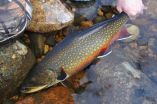(Press-News.org) TALLAHASSEE, Fla. — A new study by Florida State University researchers demonstrates a different way of projecting a hurricane's strength and intensity that could give the public a better idea of a storm's potential for destruction.
Vasu Misra, associate professor of meteorology and co-director of the Florida Climate Institute, and fourth-year doctoral student Michael Kozar introduce in the Monthly Weather Review of the American Meteorological Society a new statistical model that complements hurricane forecasting by showing the size of storms, not just the wind speed.
The model predicts the amount of integrated kinetic energy within Atlantic tropical cyclones. This kinetic energy metric is related to the overall size and strength of a storm, not just the maximum wind speed. Predictions of this metric complement existing forecasting tools, potentially allowing forecasters to better assess the risk of hurricanes that make landfall.
"We don't perceive this to be an alternative to how storms are explained to the public, but a complement," Misra said.
Hurricane forecasts have traditionally focused on wind speeds as measured through the Saffir-Simpson Hurricane Wind Scale. For example, a storm that has wind speeds of 74 to 95 miles per hour would be called a Category 1 storm. A hurricane with wind speeds of 157 miles per hour or higher would be listed as a Category 5.
However, some of the most destructive hurricanes to hit the United States have been labeled a Category 1 or Category 2 because of their slower wind speeds.
Hurricane Ike, for example, was a category two storm when it made landfall in 2008, meaning it had maximum sustained winds of 96 to 110 miles per hour. Despite the modest rating on the Saffir-Simpson Hurricane Wind Scale, Hurricane Ike caused widespread destruction because it was such a large storm.
"When the National Hurricane Center says Category 1, the attitude by the public is that it's fine and they can live through it," Misra said. "But, the damage by flooding is typically more widespread in larger storms."
Added Kozar: "It's the wind that gets all the attention, but it's the flooding that causes much of the damage."
Kozar and Misra's work thus far has focused on using data on storms dating back to 1990. The next step in their research is to focus on real-time weather prediction, so they can show the model in action.
INFORMATION:
The research is supported by funding from NOAA and the U.S. Department of Agriculture.
CONTACT: Kathleen Haughney, University Communications
(850) 644-1489; khaughney@fsu.edu
Research offers new way to predict hurricane strength, destruction
2014-09-15
ELSE PRESS RELEASES FROM THIS DATE:
This is your brain on snacks -- brain stimulation affects craving and consumption
2014-09-15
September 15, 2014 - Magnetic stimulation of a brain area involved in "executive function" affects cravings for and consumption of calorie-dense snack foods, reports a study in the September issue of Psychosomatic Medicine: Journal of Biobehavioral Medicine, the official journal of the American Psychosomatic Society. The journal is published by Lippincott Williams & Wilkins, a part of Wolters Kluwer Health.
After stimulation of the dorsolateral prefrontal cortex (DLPFC), young women experience increased cravings for high-calorie snacks—and eat more of those foods when ...
Delay in age of walking can herald muscular dystrophy in boys with cognitive delays
2014-09-15
The timing of a toddler's first steps is an important developmental milestone, but a slight delay in walking is typically not a cause of concern by itself.
Now a duo of Johns Hopkins researchers has found that when walking and cognitive delays occur in concert, the combination could comprise the earliest of signals heralding a rare but devastating disorder known as Duchenne muscular dystrophy (DMD).
The study, published ahead of print in The Journal of Pediatrics and conducted by a medical student and a pediatric neurologist, reveals that delays in the onset of walking ...
Caregivers of family members newly diagnosed with mental illness at risk for anxiety
2014-09-15
Researchers at Case Western Reserve University School of Nursing, who studied the emotional distress of caring for a family member diagnosed with a mental illness, found anxiety is high for the primary caregiver at the initial diagnosis or early in the course of the illness and decreases over time.
"This finding is significant," said Jaclene A. Zauszniewski, PhD, RN-BC, FAAN, the Kate Hanna Harvey Professor of Community Health at the Frances Payne Bolton School of Nursing and study's corresponding author.
She attributes the differences to possibly two factors: the family ...
Working long hours may increase risk of coronary heart disease
2014-09-15
Working more than a 40-hour week has been linked to stress, dissatisfaction, and compromised health, and now new research on 8,350 Korean adults finds that it may also increase one's risk of developing coronary heart disease, or narrowing of the blood vessels that supply blood and oxygen to the heart.
"The longer hours employees worked, the higher their chances of developing coronary heart disease within 10 years, with those working 61 to 70 hours having a 42% increased likelihood of developing the disease, those working 71 to 80 hours having a 63% increased likelihood, ...
Study finds drop in death rates from strokes over last 2 decades
2014-09-15
Despite the significant reduction in the overall incidence and death rates from strokes in the United States over the past twenty years, more attention needs to be paid to specific age groups, a recent study found.
The new research, conducted by Dr. Silvia Koton of Tel Aviv University's Sackler Faculty of Medicine and the Bloomberg School of Public Health at Johns Hopkins University, Prof. Josef Coresh of the Bloomberg School of Public Health, and a team of experts at Hopkins, the University of North Carolina, Chapel Hill and the University of Arizona, found a 24 percent ...
Genes may help explain why some people are naturally more interested in music than others
2014-09-15
Research suggests that genes that affect hearing and cognitive function may play roles in one's musical aptitude, or the ability to understand and perceive rhythm, pitch, timbre, tone durations, and formal structure in music.
The authors of a BioEssays article explain that extremes in musical aptitude (extreme capacity/no capacity) are rare within a population, with the majority of individuals having moderate aptitude.
"This is a typical feature of a complex trait attributable to several underlying genes, and it is influenced to varying degrees by environmental factors, ...
How are hybridized species affecting wildlife?
2014-09-15
Researchers who transplanted combinations of wild, domesticated, and domesticated-wild hybridized populations of a fish species to new environments found that within 5 to 11 generations, selection could remove introduced foreign genes from wild populations that hybridized with domesticated populations.
The Evolutionary Applications study provides evidence that natural selection, over time, removes the adaptive advantages that hybridized populations experience as a result of increased genetic diversity.
"The results may be useful for policy makers who classify the protection ...
When casualties increased, war coverage became more negative
2014-09-15
As the number of U.S. casualties rose in Afghanistan, reporters filed more stories about the conflict and those articles grew increasingly negative about both the war effort and the military, according to a Penn State researcher. "When the war in Afghanistan started, the tone of the stories that reporters filed was generally neutral," said Michel Haigh, associate professor of communications. "However, over time, and as casualties increased, the coverage became more negative." In 2003, as the media began to focus more on the conflict in Iraq, reporters wrote less than 20 ...
If hippopotamuses can't swim, how can some be living on islands?
2014-09-15
There is no published account where hippopotamuses are demonstrably shown swimming or floating at the surface of any body of water. But if they can't swim, how did they reach and colonize islands?
Experts say that widely accepted models for the methods, patterns, and timing of the colonization and dispersal to several islands (e.g. Cyprus, Crete, and Madagascar) may need to be reconsidered.
"Although land bridge connections between these islands and the mainland are not currently supported by positive geological evidence, neither is there any contradictory evidence ...
People are attracted to the body odor of others with similar political beliefs
2014-09-15
A new study reveals that people find the smell of others with similar political opinions to be attractive, suggesting that one of the reasons why so many spouses share similar political views is because they were initially and subconsciously attracted to each other's body odor.
During the study, 146 participants rated the attractiveness of the body odor of unknown strong liberals and strong conservatives, without ever seeing the individuals whose smells they were evaluating.
"People could not predict the political ideology of others by smell if you asked them, but they ...


